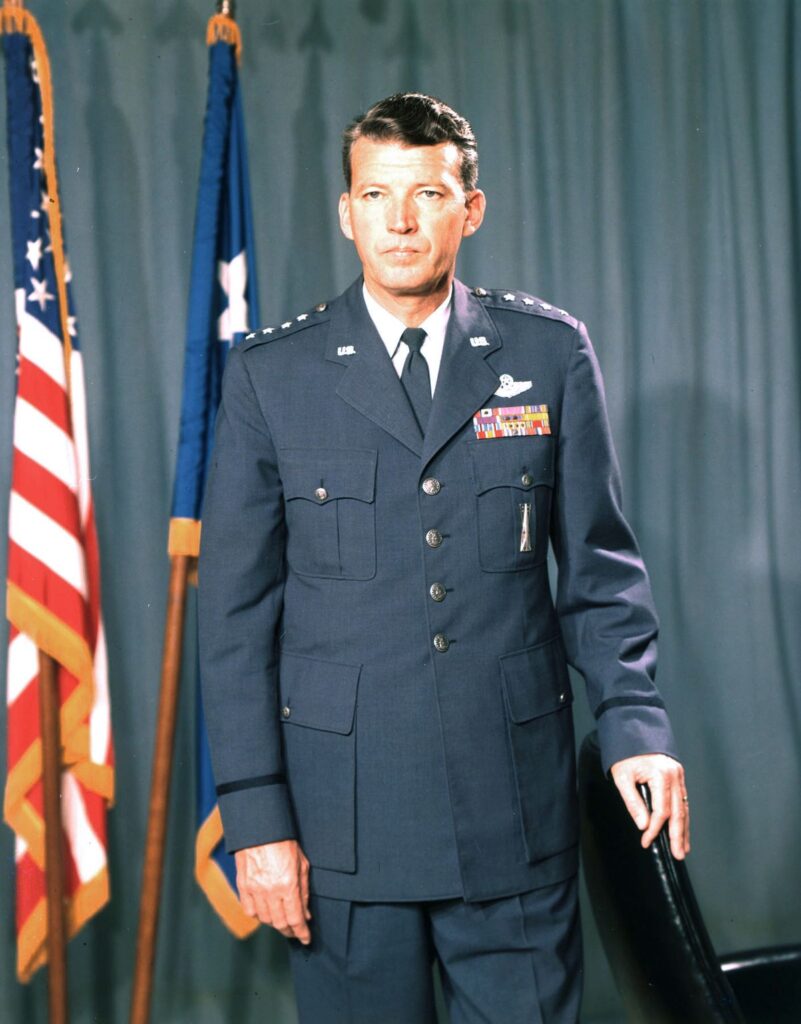Bernard Schriever was born in Bremen, Germany on September 14, 1910. His father, a German merchant marine sailor, was interned in New York in 1916 during World War I, so the rest of the family immigrated to the United States in 1917. They settled in the German-American community of New Braunfels, Texas. His father was killed in an accident in 1918 and Schriever’s mother Elizabeth raised Bernard and his brother on her own, working as a housekeeper and at other jobs. Schriever became a U.S. citizen in 1923 and attended public schools in nearby San Antonio. Graduating from Texas A&M University in 1931, he began his military career with a reserve appointment in the field artillery then earned his pilot wings in 1933. In 1942, Schriever received a Masters degree in Aeronautical Engineering from Stanford University.
Bernard Schriever served as a bomber pilot in World War II and held numerous high-level positions with the post-war Air Force. In 1954, he assumed command of the Air Force Ballistic Missile Division, Air Research, and Development Command in Los Angeles, California. In this capacity, he directed the nation’s highest priority project, the development of an intercontinental ballistic missile (ICBM). He was responsible not only for pushing forward research and development of the Atlas, Titan, Thor, and Minuteman ballistic missiles, but for concurrently providing the launching sites and equipment; tracking facilities, and ground support equipment necessary to these missiles. The techniques he developed for the Air Force’s ballistic missile program have contributed substantially to the nation’s aerospace capability.
In April 1959, General Schriever was promoted to commander of the Air Research and Development Command (ARDC), responsible for developing and maintaining the U.S. Air Force’s global capabilities. He managed more than 6,400 research and development contracts that engaged some 1,500 major companies in projects on every continent. In April 1961, Air Force Systems Command (AFSC) was established, incorporating ARDC and some elements of Air Materiel Command. Bernard Schriever was named to head AFSC and was promoted to four-star general.
Schriever was justifiably called the “American Korolev,” and was one of the driving forces behind U.S. rocketry in the early Cold War years (Sergei Korolev was the principal architect of the early Soviet space program). Schriever’s accolades include both the “Father of the Air Force space program” and “Father of the ballistic missile program.” He was one of the original ten people selected to receive the Air Force Space and Missile Pioneers Award, given by the Air Force Space Command to recognize individuals who played a significant role in the history of Air Force space and missile programs. His official U.S. Air Force biography describes him as the “Architect of the United States Air Force space and missile programs.”
Bernard Schriever was one of the recipients of the Air Force Institute of Technology’s (AFIT) “Distinguished Graduate” award. This award is given to AFIT graduates who made significant contributions to our nation and who, through their inquisitive minds and extraordinary achievements, exemplify the AFIT’s idea of “excellence through knowledge.”
Schriever was a truly unique leader of America’s missile and space programs and an independent and creative thinker. Early in his career, he earned the respect of influential figures in the Air Force such as General Henry H. “Hap” Arnold, General Thomas D. White, General Curtis LeMay, General Donald L. Putt. Simon Ramo, the chief civilian in the ICBM program, believed that another general in Schriever’s position, “would have had only some of the talents with which Schriever was endowed, and the programs simply would not have gone as well.” General Schriever matched the needs of the ICBM and space programs perfectly and his availability was fortuitous.
General Schriever’s organization could rightfully take credit for having won America’s race for missile supremacy with the USSR. The progression of the Thor Intermediate Range Ballistic Missile, from program approval to initial operational capability, had taken only three and one-half years. Atlas’s development time was little more than five years, better than a 1954 estimate of six to eight years, which, at the time, was thought to be optimistic. Titan took less than six years to reach operational status. Moreover, even as the first Titan lifted off from Cape Canaveral, the Air Force was developing the more advanced Titan II. The Minuteman, whose development Schriever began, from start to finish took only four years and eight months to deploy. The first ten Minutemen were combat alert in their underground silos in October 1962.
Bernard Schriever retired from the Air Force on August 1, 1966. Afterward, he consulted with civilian organizations and frequently served without fee as an advisor to the Air Force and the Department of Defense. Schriever became the only man to have an Air Force base named for him while still living when in 1998, Falcon Air Force Base near Colorado Springs, Colorado was renamed Schriever Air Force Base in his honor. He was the recipient of numerous military awards and decorations, including the Air Force Association’s 2003 Lifetime Achievement Award, which recognized him as “one of the most important officers in the history of the United States Air Force.”
General Bernard A. Schriever died on June 20, 2005, at the age of 94, in his home in Washington, D.C. He is buried in Arlington Cemetery, near other aviation pioneers. Part of his legacy is the General Bernard A. Schriever Award, which is given by the Air Force Material Command for superior program management. It recognizes an organization’s achievements and contributions that result in marked program success that includes outstanding efforts to improve cradle-to-grave customer support.

